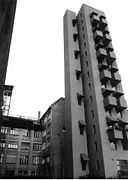John Hejduk

John Quentin Hejduk (19 July 1929 – 3 July 2000) was an American architect, artist and educator of Czech origin who spent much of his life in New York City, USA. Hejduk is noted for his use of attractive and often difficult-to-construct objects and shapes; also for a profound interest in the fundamental issues of shape, organization, representation, and reciprocity.
Hejduk studied at the Cooper Union School of Art and Architecture, the University of Cincinnati, and the Harvard Graduate School of Design, from which he graduated with a Masters in Architecture in 1953. He worked in several offices in New York including that of I. M. Pei and Partners and the office of A.M. Kinney and Associates. He established his own practice in New York in 1965.[1]
Career
Hejduk is associated with several schools, including the New York Five (from the MoMA publication Five Architects that also included works of the architects Peter Eisenman, Richard Meier, Michael Graves, and Charles Gwathmey), and the Texas Rangers (a group of innovative architects and professors at the Texas School of Architecture, Austin; other well-known participants include Colin Rowe and Werner Seligmann). Hejduk was Professor of Architecture at The Cooper Union for the Advancement of Science and Art, School of Architecture from 1964 to 2000 and Dean of the School of Architecture from 1975 to 2000. His arrival including the cooperation of many other influential professors (including Raimund Abraham, Ricardo Scofidio, Peter Eisenman, Charles Gwathmey, Diana Agrest, Diane Lewis, Elizabeth Diller, David Shapiro, Don Wall and many others) transformed the practice and critical thought of architecture in ways that might be compared to Ludwig Mies Van Der Rohe's transformation of the Armour Institute into the Illinois Institute of Technology.[citation needed]
His early work and curriculum grew from a set of exercises exploring cubes, grids, and frames, through an examination of square grids placed within diagonal containers set against an occasional curving wall, towards a series of experiments with flat planes and curved masses in various combinations and colors.[1] To aid his research he was awarded a grant from the Graham Foundation in 1967. Eventually, John Hejduk's "hard-line" modernist space-making exercises, heavily influenced by Frank Lloyd Wright and Ludwig Mies Van Der Rohe, moved away from his interests in favor of free-hand "figure/objects" influenced by mythology and spirituality, clearly expressing the nature of his poetry.[citation needed] The relationship between Hejduk's shape/objects and their surroundings is a controversial subject, raising questions similar to those raised by the early houses of Peter Eisenman. The built work of Hejduk began to appear in the 1980s (Mask of Medusa, Brazil; Kreuzberg Tower, Berlin; House for Two Brothers, Tegel Harbor - Berlin; Security (Interventions), Berlin; etc...) and continue beyond his death. (Wall House 2, Groningen, NL; and Hejduk Tribute Towers, Galicia Cultural Center - Santiago de Compostela Peter Eisenman).
Contemporary theorists, researchers, and academics publishing work and research by and about John Hejduk include K. Michael Hays, Mark Linder, R.E. Somol, and Renata Hejduk.
A large portion of his work is archived at the Canadian Centre for Architecture in Montreal.
Important buildings
- House For a Musician (1983)
- House of the Suicide and House of the Mother of the Suicide
- Kreuzberg Tower and Wings (Berlin, Allemagne, 1988)
- Tegel Housing (Berlin, 1988)
- House of the Quadruplets / House for two Brothers (Berlin, Tegel, 1988)
- Gate House (Berlin, 1991) for the IBA 87
- La Máscara de la Medusa (Buenos Aires, 1998)
- Wall House II (Groningen, 2001)
- Important buildings of John Hejduk
-

Kreuzberg Tower and Wings
(Berlin, Germany, 1988). -

Kreuzberg Tower and Wings
(Berlin, Germany, 1988). -
Wall House II
design from the 1970s, built posthumously (Groningen, The Netherlands, 2001).
Bibliography
- Education Of An Architect A Point Of View (1988, 1999)
- Pewter Wings Golden Horns Stone Veils: Wedding in a Dark Plum Room (1997)
- Adjusting Foundations (1995)
- Architectures In Love (1995)
- Security (1995)
- Berlin Night (1993)
- Soundings (1993)
- Aesop's Fables with Joseph Jacobs. Illustrations by John Hejduk. (1991)
- Práce (Practice) (1991)
- The Riga Project (1989)
- Vladivostok (1989)
- Bovisa (1987)
- Mask of Medusa (1985)
- Fabrications (1974)
- Three Projects (1969)
References
- ↑ 1.0 1.1 "John Hejduk". Great Buildings Collection. Retrieved 18 January 2009.
External links
| Wikimedia Commons has media related to John Hejduk. |
- Georgia Tech Sculptures to Appear in Hejduk Retrospective at Whitney Museum
- John Hejduk archive at the Canadian Centre for Architecture
|

